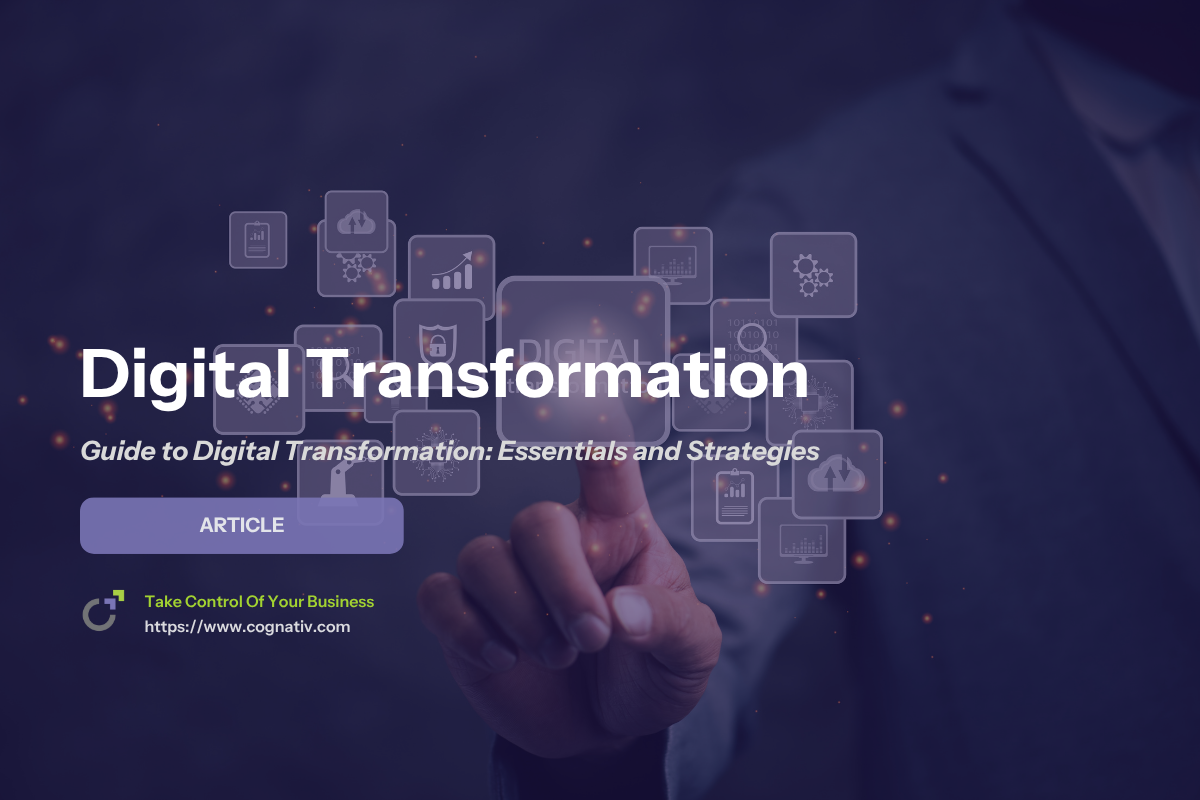Guide to Digital Transformation: Essentials and Strategies
Digital transformation means using digital technology to fundamentally change your business operations and how you deliver value to customers. It’s essential for staying competitive and meeting modern customer expectations. In this guide, we’ll explore what digital transformation is, why it’s critical, and how to implement it effectively.
Key Takeaways
-
Digital transformation encompasses integrating technology with business processes, requiring a comprehensive rethinking of business models and cultural shifts to meet evolving customer expectations.
-
Key drivers of digital transformation include enhanced customer experiences, competitive pressures, and the need for operational efficiency, with a focus on breaking down data silos and fostering innovation.
-
Successful digital transformation demands a strategic approach aligned with business goals, incorporating diverse team collaboration, ongoing training, and effective change management to navigate challenges and measure ROI.
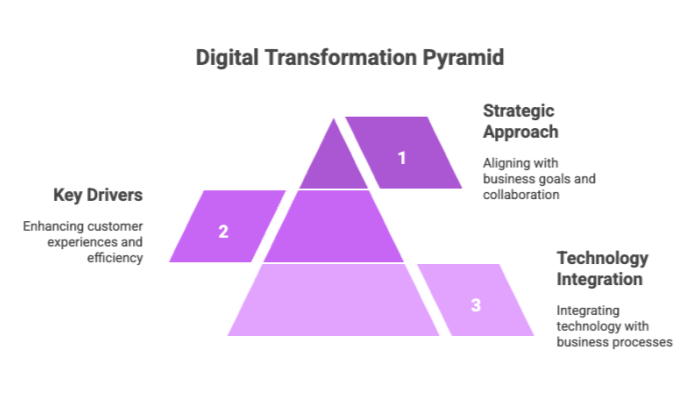

Understanding Digital Transformation
Digital transformation means integrating technology with business processes to fundamentally change how organizations operate and deliver value to customers. It’s not merely about adopting new digital tools but reimagining the entire business model. This comprehensive transformation encompasses cultural shifts, rethinking processes, and leveraging digital data to drive decisions.
Digital transformation is now a necessity for businesses due to rapid technological advancements and industry disruptions. Organizations must adapt to meet customers’ expectations of interacting with services anytime, anywhere, on any device. The COVID-19 pandemic further accelerated this shift, pushing many businesses to embrace digital solutions to survive and thrive.
Achieving successful digital transformation involves balancing strategy, structure, systems, skills, shared values, style, and staff. Organizations should tailor their approach based on customer value, ensuring alignment with their unique business goals. This alignment enhances customer experiences, streamlines operations, and maintains competitiveness in the digital age.
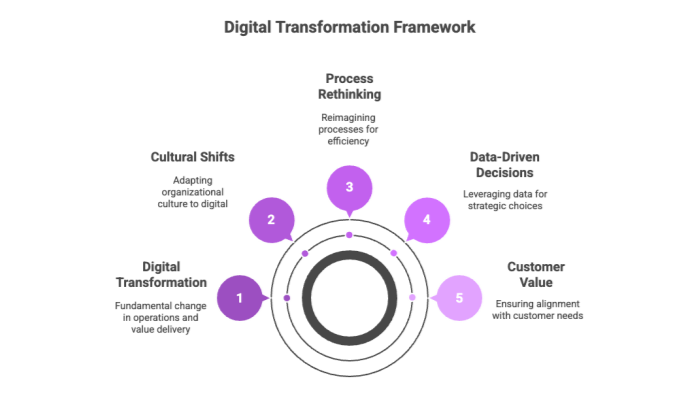

Key Drivers of Digital Transformation
The key drivers of digital transformation are multifaceted, but at the core, it’s about meeting and exceeding customer expectations. Enhanced digital experiences have elevated what customers expect from businesses, compelling them to continually improve their digital offerings. Consumers now demand the ability to conduct business anytime, anywhere, and on any device, making digital solutions a crucial aspect of their purchasing decisions.
Competition is another crucial driver. As industries such as insurance and retail undergo digital transformations, others must follow to stay competitive. Business model innovation often emerges as companies respond to market consumption shifts and competitive landscapes, making it a business imperative. For instance, business leaders at companies like Audi leverage data and digital innovations to enhance customer experience and stay ahead.
Moreover, improving work for employees and streamlining production processes are vital for overall efficiency and customer satisfaction. Breaking down data silos and fostering data literacy drive digital transformation. Telecom, Media, and Technology companies, for example, create innovative services and use analytics to enhance customer experiences. Understanding these drivers helps organizations prioritize their digital transformation strategies effectively.
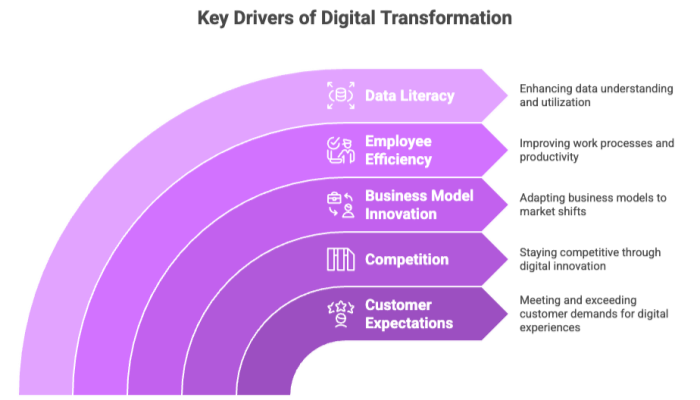

Core Areas of Digital Transformation
Digital transformation impacts several core areas within an organization. These areas include business model innovation, process optimization, and product and service enhancement. Each area plays a crucial role in reshaping how businesses operate and compete in the digital era.
Understanding the significance of each core area reveals how they contribute to a successful digital transformation.
Business Model Innovation
Business model innovation is at the heart of digital transformation. Organizations are rethinking traditional business models to better align with the evolving demands of digital consumers. This transformation involves a fundamental change in how an organization delivers products, services, and value to its customers. For example, Netflix’s content recommendation system, which utilizes AI, represents a significant shift in how entertainment is delivered and consumed.
A digital-first approach enables businesses to scale their systems easily as they grow, meeting changing customer expectations and differentiating in a competitive market. Small and medium-sized businesses should develop scalable capabilities to achieve successful digital transformation.
Business model innovation is not just about adopting new technologies but also about redefining how a business operates and engages with its customers. By embracing digital innovations, organizations can create new revenue streams, enhance customer experiences, and stay ahead of the competition through a solid business strategy.
Process Optimization
Process optimization enhances operational efficiency by modifying systems and workflows. Automation can significantly increase productivity and reduce inefficiencies. For example, Wintershall Dea automated data extraction from 2,000 PDF documents, showcasing the practical benefits of automation.
Integrating process optimization into digital transformation strategies is crucial for sustainable growth in a competitive landscape. By leveraging digital tools and technologies, businesses can streamline workflows, automate tasks, and reduce manual labor, ultimately improving overall operational efficiency and agility.
Product and Service Enhancement
Integrating digital technologies into products and services helps businesses meet evolving customer expectations. For example, manufacturers can use sensor data to identify product flaws and optimize machinery maintenance. This proactive approach not only improves product quality but also enhances customer satisfaction.
Digital product management shifts from projects to products that enhance customer experience. Web and app-based self-service portals in sectors like insurance enable easy comparison shopping, enrollment, and claims filing, significantly improving customer experiences. Digital product managers play a crucial role in this transition.
By leveraging new technologies and emerging technologies, enabling businesses can offer innovative digital services and products that meet the demands of today’s digital consumers.
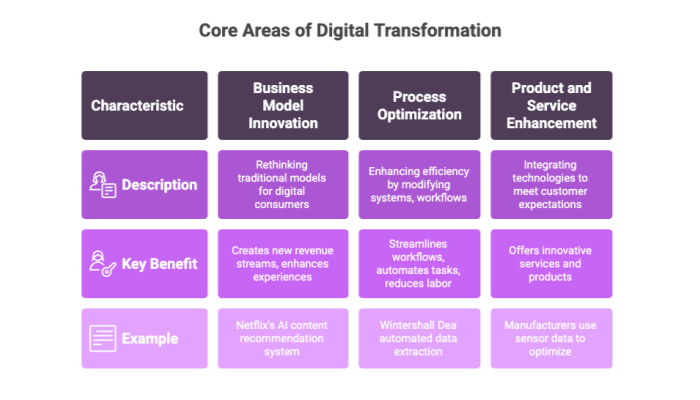

Technologies Enabling Digital Transformation
Key technologies driving digital transformation reshape business operations:
-
Artificial Intelligence (AI): Drives innovation by leveraging data for competitiveness.
-
Machine learning: Mimics human capabilities, processes tasks, and personalizes customer interactions.
-
Retail applications: Retailers use AI and machine learning for personalized marketing strategies, effectively engaging customers.
Cloud computing provides scalable IT infrastructure and cloud infrastructure, essential for remote collaboration and business growth. Migration to technology infrastructure and cloud technologies supports organizations in scaling their operations and enhances overall flexibility.
The Internet of Things (IoT) equips devices to collect and transmit real-time relevant data, essential for informed decision-making. IoT-enabled sensors, for instance, provide insurers with critical data for better forecasting and claims management.
Mobile devices have driven early digital transformation initiatives and contributed to the creation of new business models. Technologies driving digital transformation also include mobile computing, alongside AI and IoT and digital technology. These digital initiatives collectively enable businesses to innovate, streamline operations, and meet the demands of the digital age, facilitating technology adoption and digital innovation.
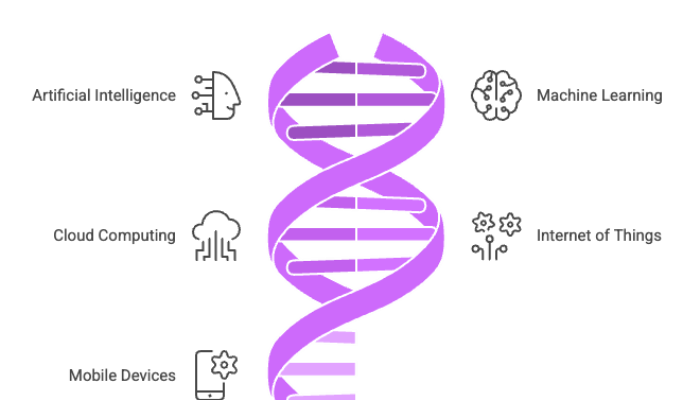
Benefits of Embracing Digital Transformation
Embracing digital transformation offers numerous benefits for business operations and customer engagement. A significant advantage is the ability to deliver personalized experiences, improving customer satisfaction and loyalty. Enhancing customer experience is a key motivator for digital transformation initiatives, as businesses strive to improve interactions and build stronger relationships.
Digital transformation also confers a competitive advantage by:
-
Attracting talent and enhancing business value.
-
Improving operational efficiency through automation and streamlined workflows, enabling organizations to accomplish tasks faster and with greater accuracy.
-
Allowing businesses to respond swiftly to market changes and customer demands, fostering innovation and growth within a digital transformation framework.
Global investment in digital transformation is projected to reach $2.3 trillion by 2023, underscoring its significance in modern business strategies for global enterprises. Leveraging digital technologies enables organizations to tap into new revenue opportunities, optimize sales strategies, and reach new markets. Ultimately, digital transformation drives innovation, allowing companies to evolve and meet changing customer expectations through technology investments.
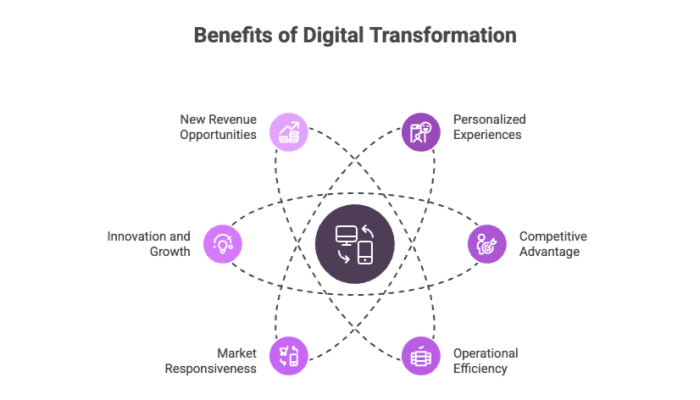

Challenges in Digital Transformation
Despite its benefits, digital transformation presents challenges. Cultural challenges arise from prevailing mindsets within organizations, especially where traditional processes are deeply entrenched. Shifting to a digital-first company culture requires significant change management and employee buy-in.
Many organizations also struggle with insufficient IT skills, which significantly impacts their capabilities for effective digital transformation. Budgetary limitations can further hinder the progress of digital transformation initiatives, especially when there is scope creep.
Moreover, complex software development systems and training difficulties contribute to integration issues that undermine digital transformation efforts. Recognizing and addressing these challenges is crucial for achieving successful transformation.
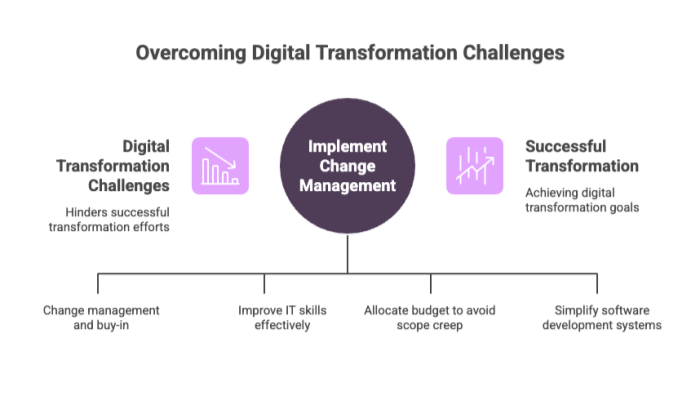
Strategies for Successful Digital Transformation
Successfully implementing digital transformation requires careful planning and execution. Strategies should prioritize business outcomes over technology. Technology implementation plans must align with established business strategies, and organizations should define their business goals before starting digital transformation.
Involving a diverse team across various departments enhances the success of digital transformation initiatives. Feedback from stakeholders is essential to refine and adjust the digital transformation strategy over time. Scaling successful digital transformation initiatives and transformation projects can involve applying strategies across multiple locations and technologies.
Ongoing workforce training equips employees to empower employees with the skills to navigate digital tools successfully. Organizations with robust change management strategies are more likely to meet their digital transformation goals. By focusing on these strategies, businesses can effectively leverage technology to drive transformation and achieve their objectives.
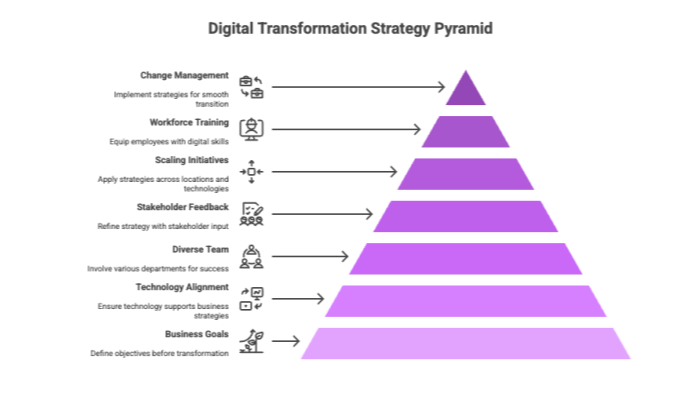

Real-World Examples of Digital Transformation
Real-world examples of digital transformation in the digital world provide valuable insights into how various industries are leveraging digital technologies to innovate and stay competitive.
Let’s explore how digital transformation is making an impact in the retail, healthcare, and financial services sectors.
Retail Industry
Digital transformation has significantly improved the retail experience by:
-
Enhancing in-store experiences
-
Improving e-commerce platforms
-
Developing loyalty programs
-
Enhancing customer interaction points
-
Utilizing automated systems to create a seamless shopping experience
For instance, IoT technology in retail enables automated reordering processes, boosting operational efficiency.
Retailers respond to shifts in consumer behavior and business models induced by e-commerce through digital transformation by embracing advanced analytics and customer intelligence tools. These tools provide valuable insights into consumer preferences, allowing retailers to tailor their offerings and improve customer engagement.
By leveraging digital technologies, retailers can enhance their digital business operations and stay competitive in the digital age.
Healthcare Sector
Digital transformation in healthcare facilitates remote patient monitoring, enhancing care delivery. Integrating digital technologies improves workflows and increases service delivery speed, boosting overall operational efficiency. For example, digital platforms enable healthcare providers to monitor patients remotely, reducing the need for in-person visits and improving patient outcomes.
Digital transformation is crucial for healthcare providers as it enhances both patient care and operational efficiency. By leveraging digital tools and technologies, healthcare organizations can streamline their processes, improve patient engagement, and deliver better care. This transformation ultimately leads to improved health outcomes and increased patient satisfaction.
Financial Services
Capital One transformed its operations by integrating software at the core, significantly innovating its banking services. Banking institutions increasingly adopt digital solutions to enhance services and operations. These solutions streamline processes, improve customer experience, and respond to market demands more swiftly.
The continuous adoption of digital solutions is essential for banks to remain competitive in an evolving marketplace. By leveraging digital technologies, financial institutions can optimize their operations, enhance customer engagement, and drive innovation. This transformation ultimately leads to improved business outcomes and increased customer satisfaction.
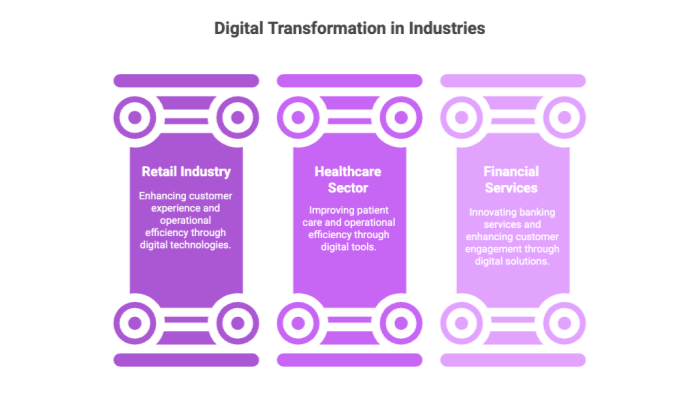

Measuring the ROI of Digital Transformation
Measuring the return on investment (ROI) for digital transformation can be complex due to intangible benefits. However, data-driven decision-making is essential for unlocking new opportunities and navigating challenges effectively. Real-time data analysis from digital transformation provides insights that inform decision-making.
Financial KPIs assess the monetary impact of digital transformation on the organization’s bottom line, including metrics like revenue growth, cost savings, and profitability. Project management key performance indicators track completion rates and resource allocation of digital transformation initiatives. Monitoring these KPIs helps organizations evaluate the effectiveness of their efforts and make informed decisions to optimize strategies.
Ultimately, measuring the ROI of digital transformation requires a comprehensive approach considering both tangible and intangible benefits. Leveraging data and analytics, organizations can gain valuable insights into the impact of their initiatives and continuously improve strategies to achieve better business outcomes.
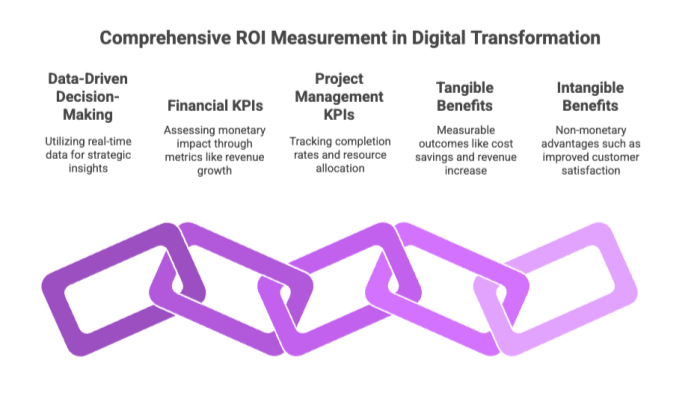

Future Trends in Digital Transformation
As we look to the future, the landscape of digital transformation is becoming more complex. In 2024, digital transformation will focus on pragmatic cases like launching new products and entering new markets, reflecting the maturity of transformation efforts and the need to deliver tangible results.
However, barriers like misaligned incentives and legacy systems are intensifying, making it more challenging to implement digital transformation strategies effectively and maintain the status quo. To overcome these challenges, businesses must continue to innovate and adapt strategies to stay competitive in the digital era.
By staying ahead of digital transformation trends, organizations can capitalize on new opportunities and drive sustainable growth.
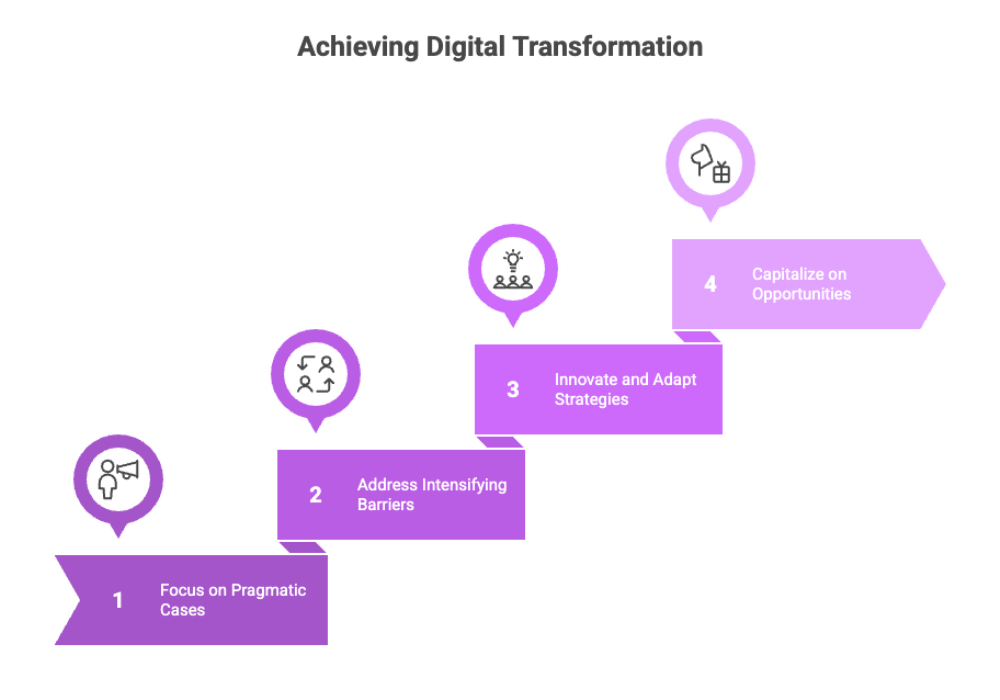

Summary
Digital transformation is not just a technological shift but a comprehensive rethinking of how businesses operate and deliver value. By understanding the core areas of digital transformation—business model innovation, process optimization, and product and service enhancement—organizations can better navigate their transformation journeys. Key drivers such as customer expectations, competition, and technological advancements compel businesses to evolve and adapt.
Embracing digital transformation offers numerous benefits, from enhanced customer engagement and operational efficiency to increased innovation and competitive advantage. However, organizations must also be aware of the challenges, including cultural resistance, skill gaps, and budget constraints. By implementing well-thought-out strategies and leveraging enabling technologies, businesses can successfully transform and thrive in the digital era. The future of digital transformation promises even more opportunities, and staying informed about emerging trends will be crucial for continued success.

Frequently Asked Questions
This FAQ section addresses some of the most common questions about digital transformation, providing clear and concise answers to help you understand its importance, core concepts, and practical applications. It also highlights how emerging technologies like natural language processing (NLP) contribute to transforming business functions and improving customer interactions.
What is digital transformation?
Digital transformation fundamentally changes how organizations operate and deliver value by integrating technology with business processes. It requires cultural shifts and a rethinking of processes, emphasizing the use of digital data to inform decisions.
What are the key drivers of digital transformation?
The key drivers of digital transformation are enhanced customer expectations, increased competition, rapid technological advancements, and the necessity for improved operational efficiency and customer engagement. Embracing these factors is essential for organizations seeking to thrive in a digital age.
What are the core areas of digital transformation?
The core areas of digital transformation are business model innovation, process optimization, and product and service enhancement, each essential for redefining operational and competitive strategies in today's digital landscape.
What technologies enable digital transformation?
Digital transformation is enabled by key technologies such as Artificial Intelligence (AI), machine learning, natural language processing (NLP), cloud computing, the Internet of Things (IoT), and mobile devices. These innovations allow businesses to enhance efficiency and adapt to the evolving digital landscape.
How can organizations measure the ROI of digital transformation?
Organizations can measure the ROI of digital transformation by tracking financial KPIs like revenue growth and cost savings, alongside project management KPIs such as completion rates and resource allocation. Utilizing data-driven insights and real-time analysis is crucial for effectively evaluating these transformations.
What is digital transformation?
Digital transformation fundamentally changes how organizations operate and deliver value by integrating technology with business processes. It requires cultural shifts and a rethinking of processes, emphasizing the use of digital data to inform decisions.
What are the key drivers of digital transformation?
The key drivers of digital transformation are enhanced customer expectations, increased competition, rapid technological advancements, and the necessity for improved operational efficiency and customer engagement. Embracing these factors is essential for organizations seeking to thrive in a digital age.
What are the core areas of digital transformation?
The core areas of digital transformation are business model innovation, process optimization, and product and service enhancement, each essential for redefining operational and competitive strategies in today's digital landscape.
What technologies enable digital transformation?
Digital transformation is enabled by key technologies such as Artificial Intelligence (AI), machine learning, cloud computing, the Internet of Things (IoT), and mobile devices. These innovations allow businesses to enhance efficiency and adapt to the evolving digital landscape.
How can organizations measure the ROI of digital transformation?
Organizations can measure the ROI of digital transformation by tracking financial KPIs like revenue growth and cost savings, alongside project management KPIs such as completion rates and resource allocation. Utilizing data-driven insights and real-time analysis is crucial for effectively evaluating these transformations.

